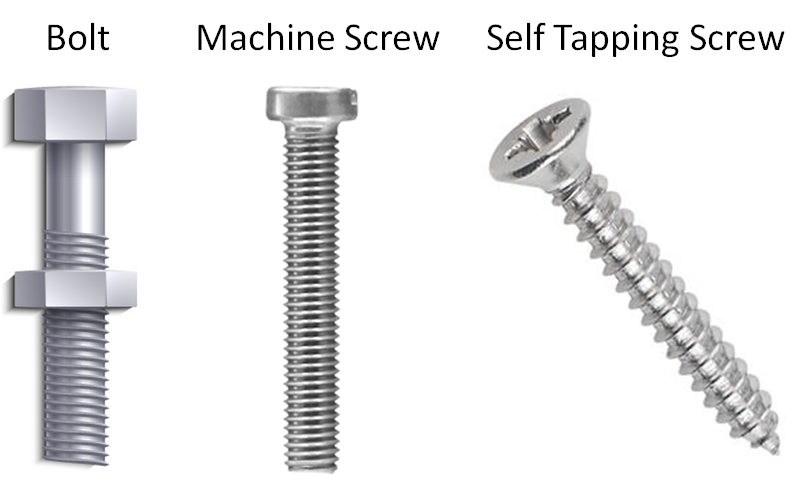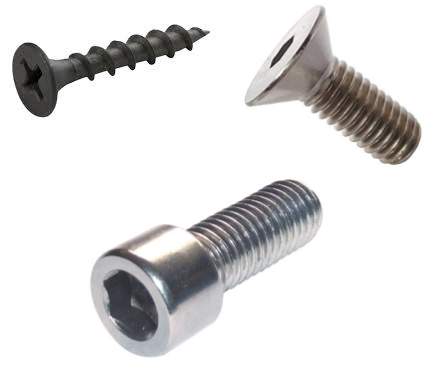Bolt and screw are mechanical fasteners used to position and hold two or more components together. But they have unique applications and characteristics. Bolts are used with nuts, whereas screws make threads of their own or are used on the threaded component. But in some scenarios bolts can work as screws if used on the threaded component.
In actual practice, there is no defined difference between bolt and screws. But there are still two different categories according to their construction and applications. In this article, we will discuss the difference between bolt and screw ( Bolt vs Screw ).

To understand the difference between bolts and screws. Let’s first try to understand what is a bolt? and what is a screw?
What is a Bolt ?
A Bolt is an externally threaded fastener used along with internally threaded components such as nuts to position and holds two or more parts. Bolts are used along with washers and nuts for high-duty applications.

During installation, the bolt remains stationary and torque is applied to the nut to hold parts together. Following are the examples of different types of bolts available in the market.
- Hex Bolt
- Anchor Bolt
- Eye Bolt
- Socket head bolt
- U-Bolt
- Shoulder Bolts
- T-Head Bolt
What is a Screw?
A Screw is an externally threaded fastener used to position and holds two or more components in one place. Screws do not require nuts and are assembled either in a tapped hole or create threads in pre-drilled holes during installation. They have applications for relatively low clamping force requirements.

During screw installation, torque is applied to the screw using a screwdriver. Following are the examples of various types of screws available in the market.
- Wooden screw
- Self-tapping plastic screws
- Self-drilling screw
- Machine screw etc.
What is the difference between Bolt and Screw?
Both bolts and screws are externally threaded fasteners used to position and hold mechanical components. Bolt requires nuts, whereas screws work on their own. Here is the list of differences between bolts and screws.
Bolts vs Screw
| Characteristics | Bolts | Screw |
|---|---|---|
| Application | Nuts are required to secure a bolt. | Screws works on its own. |
| Torque is applied to the nut. | Screwdriver apply torque on the screw. | |
| Bolts are used with non-threaded components. | Screw can be used with threaded or un-threaded components. | |
| Construction | Uniform cross section. | Can have a non-uniform cross-section. |
| Uniform Shank | Non Uniform Shank | |
| Clamping Force | Bolts along with nuts provide high clamping force. | Used for low clamping force requirements. |
| Reliability | High | Moderate |
| Load Carrying Capacity | Larger size bolts are used to achieve higher load-carrying capacity. For example, bolts are used in the construction industry. | Screws are not available in very large sizes. They are generally used for small load carrying applications. |
| Examples | Anchor bolt, Carriage bolt, Elevator bolt, Flange bolt, Hanger bolt, Hexagon bolt/Tap bolt, Lag bolt, Machine bolt, etc. | Self tapping screws, wooden screws, sheet metal screws, Machine screws, Security head screw, unidirectional screws, etc. |
| Applicable Standard | ISO 16228:2017 | |
To sum up, It is very difficult to differentiate between bolt and screw. Most bolts can be used as screws if used with threaded components. Click this link to know the various types of washers and their application.
We will keep updating this article on bolts vs screws. Add your comments, questions, or suggestions on the difference between bolts and screws.

If a threaded “thing” can be used both as a screw and as a bolt: What should I call it?
I have the exact same question.
It does get complicated by the work the bolt/screw is required to perform if the task is to connect two pieces of material together(clamping force) then a bolt with washer and a nut can be used note; make sure the shoulder/shank of the bolt is not longer than the total length of two pieces of material to be clamped (thread lock will occur and full clamping force will not be achieved)
Another task requires two pieces of material together but one of the pieces is fixed and has a threaded blind(only one way in)hole for this task to be certain of the full clamping force a set screw would be used( so as to be sure thread lock does not happen due to the shank if a bolt was used)the set screw will provide the same clamping force of a bolt the same size
I have always gone by the type of head. If a fastener has a hex (six-sided) head, it’s a bolt, and a wrench is used to turn it. If it has a round head with a single slot or cross slots in it, it is a screw, and is turned with a screwdriver. There are always exceptions to any rule, but this applies in most cases, especially where a homeowner or hobbyist is involved.
I’m Brazilian. In Portuguese, not even exists two different words for “bolt” and “screw”. We use “bolt” only for door locks or firearm mechanisms.